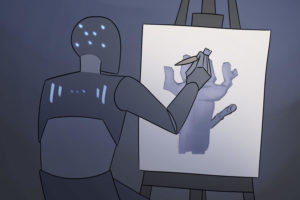February 16, 2023
An artist stares at the colors and lines filling the screen. So similar to their own work, their own personal style, yet something they’ve never before seen, foreign. Something unaffected by human influence, untouched by an artist’s hand: this is AI art.
AI art has been gaining popularity in recent weeks. However, many are concerned over the ethicality of it all.
Most see this rising form of art as harmless. It’s an easy way to replicate the styles of your favorite artists. It’s not like it hurts them or costs them. Right? It’s no different from using the artist as inspiration. Right?
What people are failing to understand, what they need to understand, is that this does hurt the artists. It does cost them. Maybe not physically, but damage does happen: figuratively, emotionally. The apps that have been creating this artificial art are stealing art from artists to use in their algorithms. Technically, it’s legal because they’re getting the art off of the web. Technically, they’re not breaking any copyright laws. Technically, there’s nothing wrong with this system. But ethically, there’s nothing right with this system either.
Artists’ names are being attached to work that isn’t theirs, just because their works were used as “inspiration”. Some pieces even show the mangled signatures of these artists, not only stealing their style but their name. Falsely crediting them for something they didn’t do, something they don’t want to be associated with.
This can be equated to someone changing the names in a book and calling themselves an author, using the same beats of a song and calling it their own. If professionals tried to do those things, there would be an uproar from creators and consumers alike. Why should AI art be any different? Why is this art form allowed more leniency than others? Why should this be allowed? Accepted even?
However, this goes deeper. Beyond just the theft of a personal style, a personal identity, is the theft of a job, a living, a way to survive in this world. Technology has rapidly been taking over our lives. Workplaces are becoming more automated, opting for robots that are more efficient, reliable, and cost-effective than human labor. It was believed that the arts would be safe from this invasion, this purging of human life; however, this belief seems to be mistaken.
Being an artist is not just a hobby for many, but a career. Just as robots are taking jobs away from factory workers, AI art is taking jobs away from artists. What’s the point in hiring an artist to make a poster when your computer can generate one in a fraction of the time? Why pay a person to create something when you can easily pay a program to recreate it until it’s just right?
From a consumer’s point of view, even a business’s point of view, AI art is definitely the way to go. What does it matter if a few artists lose the jobs they’ve so dutifully worked at all these years? Loyalty means nothing in the face of better profits. After all, business is business.
However, opting for the possibly cheaper, faster alternative does have consequences. The human touch is lost. The thing that gives art life, gives it a soul. It’s nothing more than a conglomeration of what has come before.
It’s hard to even call it art though. In and of itself, art is “the expression or application of human creative skill and imagination.” The key word being “human.”
Beyond the programmers that created the algorithm though, no human has actually touched the art that is produced. No one has altered or enhanced it. The consumer takes what the program gives them and simply accepts it.
Yet at some point, we started accepting this as art. The question shifted from classification to ethicality.
At this point though, it’s not going away. Companies will only continue to improve their algorithms, find more loopholes to escape any restrictions they come across.
Truly, the only question we should be asking ourselves is how artists can continue to survive in this technologically growing world. The answer? They can’t.













